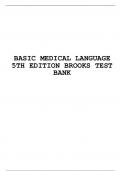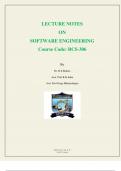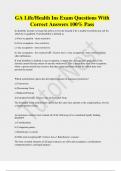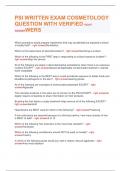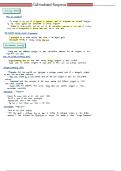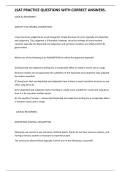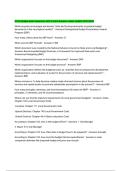H1: Introduction
1. Hans Selye & stress
Claude Bernard: internal environment of cell needs to be controlled if you want to have life
(regulation independent of the outside) emphasised need for blind experimentation
Hans Selye: combined mechanical engineering with homeostasis tried to define stress
mechanisms, largely regulated by endocrine signaling
Stress= anything that changes homeostatic state, body goes into shock and tries responding to this
signal infringement on homeostatic status
CAN ALSO BE NON-SPECIFIC
Eustress= stress raised in response to something good, might be good for body
2. General Adaptation Syndrome
2 phasic response to stress: alarm phase + general adaptation syndrome
HOMEOSTATIC LEVEL IS DIFFERENT FOR SPECIFIC ORGANISM!
ALARM PHASE IS GENERALLY VERY LONG!
1. Alarm phase: add stressor at very high dose/continuous
2. Homeostatic systems can’t deal with this resistance
goes down (shock)
3. Counterreaction: body ramps up system* to deal with this
resistance goes up
4. Resistance phase: body keeps fighting costs lot of
energy
5. Exhaustion: downregulation immune system + GI system + reproductive system/drive
YOU CAN’T KEEP FIGHTING STRESSOR FOREVER!
*3 possible systems:
1) Fight-flight response
2) Freeze response doesn’t help organism generally
3) Tend and befriend response: trying to accumulate stress in your life (depends on stressor)
response more in females (oxytocin)
Adaptati on in GAS model
Body adapts to stressor better deal with it next time!
1) Baseline of stressor goes up: takes longer to reach
exhaustion
2) Response stronger when you meet stressor
Can be combination of 2
CAN BECOME LESS RESISTANT!
1
, 3. Neuro-adrenal responses to stress
STIMULATED BY STRESS INHIBITED BY STRESS
Higher heart rate + BP Lower growth + pain response
Higher blood flow + redistribution of Lower appetite + GI activity
blood to heart, brain, skeletal muscles Lower circulation in less essential
Higher respiration + catabolism tissues
Higher hormone titers: Lower ovulation + reproductive
- CRH, ACTH, glucocorticoids function/drive
- (nor)adrenaline Lower immune function: thymus
- AVP size/hormones + cytokines
A. Endocrine HPA axis
1. Hypothalamus senses stress level release CRH
2. Activation pituitary release ACTH/corticotropin in blood
3. Stimulation kidney production cortisol (cortex) + adrenaline (medulla)
4. Body in state of alert
5. Hypothalamus sensitive to adrenaline + cortisol feedbacksystem shuts it down stressor
stays present: brain lets levels go up again
B. Sympatheti c nervous system
1. Ganglia in brain + spinal chord release (nor)adrenaline
2. Activation stress response
Alarm phase Sympathetic NS
Cortisol + adrenaline ↑
Mobilize resources
Resistance Parasympathetic NS
Blood glucose + cortisol + adrenaline remain ↑
Heart rate + blood pressure + breathing ↑
Hormone system keeps hormones + energy to stress high BODY ON
ALERT
Exhaustion Bodily resources expended
Susceptibility to disease ↑↑ : unresolved lethal
4. Stressors
Homeodynamic space shrinks as we age tight link between stress response and age: things that
help us dealing with stress, slow down ageing
The older we get, the worse we are dealing with stress!
a) Mechanical stressor f) Redox, pH, salt j) Oxygen, heavy
b) Thermal stressor g) Infection metals
c) Osmotic stressor h) Pain k) Radiation
d) Desiccation i) Emotions l) Xenobiotics
e) Starvation
Stressors can come in combinations
STRESS RESPONSE DEPENDS ON THE SUBJECT + DOSE OF THE STRESSOR!
2
,Cross-protection= some responses are relevant to many types of stress
5. Dealing with stressors
BETTER TERM IS GENERAL ACCLIMATION SYNDROME: CHANGING AT LEVEL OF INDIVIDUAL!
2 strategies to deal with stressors:
1) Conformer= go along with environment (cold env so colder body T) small animals
2) Regulator= keep things stable independent of what is on the outside (mostly live in places
where internal is close to environment) large animals
ENERGY COSLTY!
Eustress/hormesis
1. No stressor: homeodynamic state around level of susceptibility
2. Low dose of stressor susceptibility down + resistance up
3. Increase dose susceptibility up + resistance down toxic
Hormesis= having a little bit of stressor is not necessarily bad body is alert + goes to fix things it
normally wouldn’t fix (vaccination: increase immune competence)
Beneficial effects:
a) DNA repair
b) Immune competence
c) NS function
d) Stress signaling pathway
e) Mitochondrial signaling
f) Protein refolding
g) Improvement of protein homeostasis
WHAT DOESN’T KILL YOU MAKES YOU STRONGER!
H2: Thermal stress (animals)
1. Determinants of body heat and temperature
HOW ANIMALS DEAL WITH STRESS, LIMITS THE AMOUNT OF ENVIRONMENTS IT CAN LIVE IN!
Earth’s T range: -89°C (Antarctica) - >350°C (deep sea hydrothermal vents)
No temperature limit for prokaryotic life!
Endotherms: need to produce heat to cool down (limiting)
3
, Total heat in animal= heat produced + heat gained – heat lost
1) Metabolism/ respiration= electron transport chain
(mitochondria) uses H-gradient to create ATP
protons diffuse back over membrane + energy lost
as heat
2) Conduction= heat transfer between objects in
contact (kinetic energy passed on between
molecules) thermal conductivity k depends on
material
∆T
Rate of heat transfer: Q=k
l
3) Convection= heat transfer caused by movement of
gas/liquid aids conduction between solid & gas/
liquid because of replacement
4) Radiation= heat transfer by EM radiation (no direct
contact) dark bodies radiate & absorb better
than more reflective bodies
5) Evaporation= energy you use to change liquid to gas of same T
6) Heat stored= reflected by animals body T depends on surface-to-volume + T gradient +
specific heat conductance (feathers, fur, blubber decrease heat conductance)
2. Heat transfer: general mechanisms
A. BLOOD FLOW
1) Blood flow changes: vasomotor control
- Response to COLD T: redirect blood flow in body core instead of skin
keep heat in
- Response to HIGH T: redirect blood flow to skin easily lose/ gain
heat
UNDER CONTROL OF AUTONOMIC NS!
2) Countercurrent exchangers
- Feet are not endothermic (have T of environment) retain heat
because of heat exchange between artery and vein
- Migratory fish (tuna, salmon) encounter diverse T (generate heat by being active): have
blood vessels under skin instead of centrally O-rich blood from gills (cold) heated by O-
poor blood from center of body via counter current in rete mirabile muscle
UNDER CONTROL OF AUTONOMIC NS!
B. BLUBBER & FUR
1) Blubber
Insulation layer under skin regulated by blood vessel shunting
UNDER CONTROL OF AUTONOMIC NS!
2) Fur
Insulation layer on top of skin (hairs trap air) regulated by pilomotor control
Flattened fur has less insulating value: THE THICKER THE FUR, THE BETTER THE INSULATION
4
1. Hans Selye & stress
Claude Bernard: internal environment of cell needs to be controlled if you want to have life
(regulation independent of the outside) emphasised need for blind experimentation
Hans Selye: combined mechanical engineering with homeostasis tried to define stress
mechanisms, largely regulated by endocrine signaling
Stress= anything that changes homeostatic state, body goes into shock and tries responding to this
signal infringement on homeostatic status
CAN ALSO BE NON-SPECIFIC
Eustress= stress raised in response to something good, might be good for body
2. General Adaptation Syndrome
2 phasic response to stress: alarm phase + general adaptation syndrome
HOMEOSTATIC LEVEL IS DIFFERENT FOR SPECIFIC ORGANISM!
ALARM PHASE IS GENERALLY VERY LONG!
1. Alarm phase: add stressor at very high dose/continuous
2. Homeostatic systems can’t deal with this resistance
goes down (shock)
3. Counterreaction: body ramps up system* to deal with this
resistance goes up
4. Resistance phase: body keeps fighting costs lot of
energy
5. Exhaustion: downregulation immune system + GI system + reproductive system/drive
YOU CAN’T KEEP FIGHTING STRESSOR FOREVER!
*3 possible systems:
1) Fight-flight response
2) Freeze response doesn’t help organism generally
3) Tend and befriend response: trying to accumulate stress in your life (depends on stressor)
response more in females (oxytocin)
Adaptati on in GAS model
Body adapts to stressor better deal with it next time!
1) Baseline of stressor goes up: takes longer to reach
exhaustion
2) Response stronger when you meet stressor
Can be combination of 2
CAN BECOME LESS RESISTANT!
1
, 3. Neuro-adrenal responses to stress
STIMULATED BY STRESS INHIBITED BY STRESS
Higher heart rate + BP Lower growth + pain response
Higher blood flow + redistribution of Lower appetite + GI activity
blood to heart, brain, skeletal muscles Lower circulation in less essential
Higher respiration + catabolism tissues
Higher hormone titers: Lower ovulation + reproductive
- CRH, ACTH, glucocorticoids function/drive
- (nor)adrenaline Lower immune function: thymus
- AVP size/hormones + cytokines
A. Endocrine HPA axis
1. Hypothalamus senses stress level release CRH
2. Activation pituitary release ACTH/corticotropin in blood
3. Stimulation kidney production cortisol (cortex) + adrenaline (medulla)
4. Body in state of alert
5. Hypothalamus sensitive to adrenaline + cortisol feedbacksystem shuts it down stressor
stays present: brain lets levels go up again
B. Sympatheti c nervous system
1. Ganglia in brain + spinal chord release (nor)adrenaline
2. Activation stress response
Alarm phase Sympathetic NS
Cortisol + adrenaline ↑
Mobilize resources
Resistance Parasympathetic NS
Blood glucose + cortisol + adrenaline remain ↑
Heart rate + blood pressure + breathing ↑
Hormone system keeps hormones + energy to stress high BODY ON
ALERT
Exhaustion Bodily resources expended
Susceptibility to disease ↑↑ : unresolved lethal
4. Stressors
Homeodynamic space shrinks as we age tight link between stress response and age: things that
help us dealing with stress, slow down ageing
The older we get, the worse we are dealing with stress!
a) Mechanical stressor f) Redox, pH, salt j) Oxygen, heavy
b) Thermal stressor g) Infection metals
c) Osmotic stressor h) Pain k) Radiation
d) Desiccation i) Emotions l) Xenobiotics
e) Starvation
Stressors can come in combinations
STRESS RESPONSE DEPENDS ON THE SUBJECT + DOSE OF THE STRESSOR!
2
,Cross-protection= some responses are relevant to many types of stress
5. Dealing with stressors
BETTER TERM IS GENERAL ACCLIMATION SYNDROME: CHANGING AT LEVEL OF INDIVIDUAL!
2 strategies to deal with stressors:
1) Conformer= go along with environment (cold env so colder body T) small animals
2) Regulator= keep things stable independent of what is on the outside (mostly live in places
where internal is close to environment) large animals
ENERGY COSLTY!
Eustress/hormesis
1. No stressor: homeodynamic state around level of susceptibility
2. Low dose of stressor susceptibility down + resistance up
3. Increase dose susceptibility up + resistance down toxic
Hormesis= having a little bit of stressor is not necessarily bad body is alert + goes to fix things it
normally wouldn’t fix (vaccination: increase immune competence)
Beneficial effects:
a) DNA repair
b) Immune competence
c) NS function
d) Stress signaling pathway
e) Mitochondrial signaling
f) Protein refolding
g) Improvement of protein homeostasis
WHAT DOESN’T KILL YOU MAKES YOU STRONGER!
H2: Thermal stress (animals)
1. Determinants of body heat and temperature
HOW ANIMALS DEAL WITH STRESS, LIMITS THE AMOUNT OF ENVIRONMENTS IT CAN LIVE IN!
Earth’s T range: -89°C (Antarctica) - >350°C (deep sea hydrothermal vents)
No temperature limit for prokaryotic life!
Endotherms: need to produce heat to cool down (limiting)
3
, Total heat in animal= heat produced + heat gained – heat lost
1) Metabolism/ respiration= electron transport chain
(mitochondria) uses H-gradient to create ATP
protons diffuse back over membrane + energy lost
as heat
2) Conduction= heat transfer between objects in
contact (kinetic energy passed on between
molecules) thermal conductivity k depends on
material
∆T
Rate of heat transfer: Q=k
l
3) Convection= heat transfer caused by movement of
gas/liquid aids conduction between solid & gas/
liquid because of replacement
4) Radiation= heat transfer by EM radiation (no direct
contact) dark bodies radiate & absorb better
than more reflective bodies
5) Evaporation= energy you use to change liquid to gas of same T
6) Heat stored= reflected by animals body T depends on surface-to-volume + T gradient +
specific heat conductance (feathers, fur, blubber decrease heat conductance)
2. Heat transfer: general mechanisms
A. BLOOD FLOW
1) Blood flow changes: vasomotor control
- Response to COLD T: redirect blood flow in body core instead of skin
keep heat in
- Response to HIGH T: redirect blood flow to skin easily lose/ gain
heat
UNDER CONTROL OF AUTONOMIC NS!
2) Countercurrent exchangers
- Feet are not endothermic (have T of environment) retain heat
because of heat exchange between artery and vein
- Migratory fish (tuna, salmon) encounter diverse T (generate heat by being active): have
blood vessels under skin instead of centrally O-rich blood from gills (cold) heated by O-
poor blood from center of body via counter current in rete mirabile muscle
UNDER CONTROL OF AUTONOMIC NS!
B. BLUBBER & FUR
1) Blubber
Insulation layer under skin regulated by blood vessel shunting
UNDER CONTROL OF AUTONOMIC NS!
2) Fur
Insulation layer on top of skin (hairs trap air) regulated by pilomotor control
Flattened fur has less insulating value: THE THICKER THE FUR, THE BETTER THE INSULATION
4


